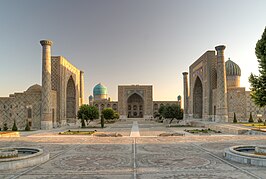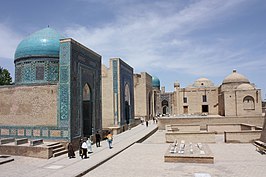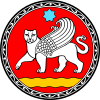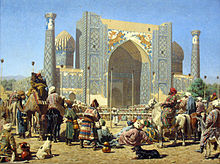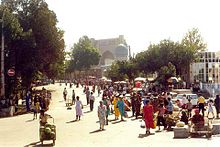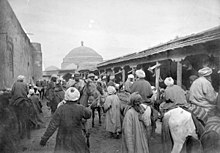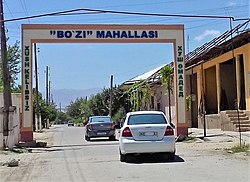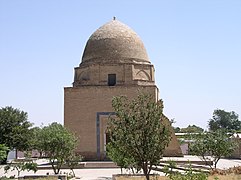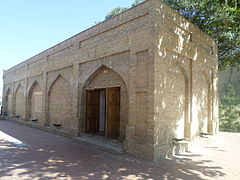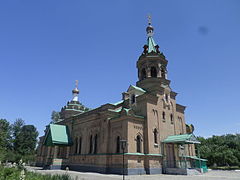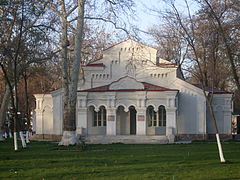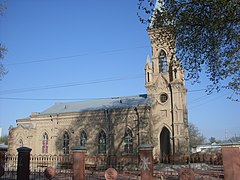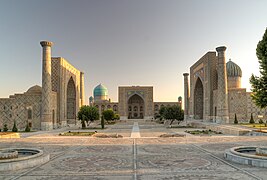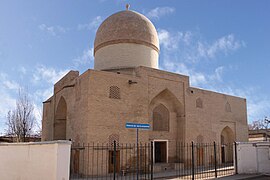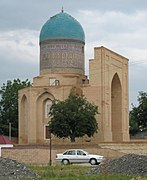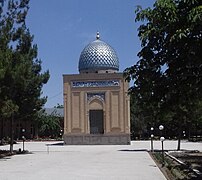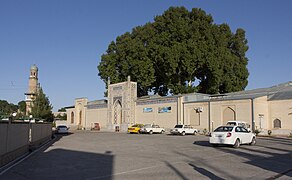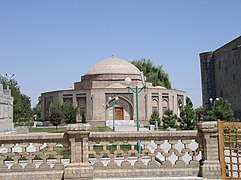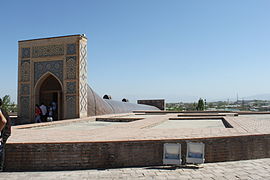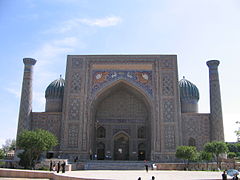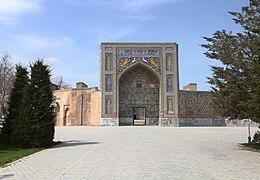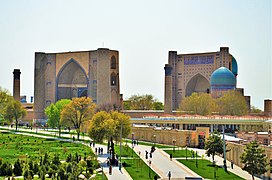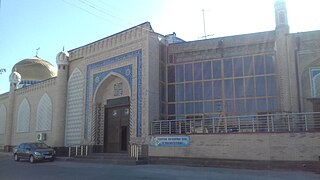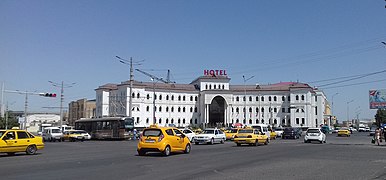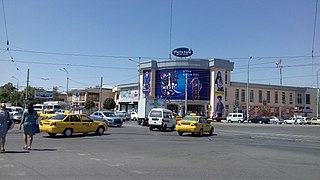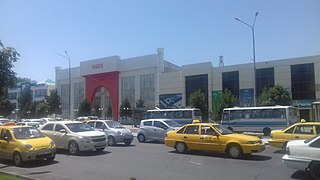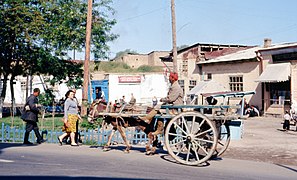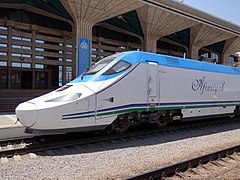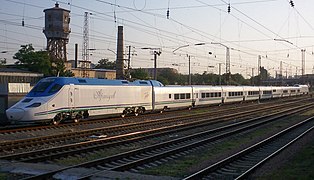Samarkand
Samarkand | |
|---|---|
City | |
| Coordinates: 39°42′N 66°59′ECoordinates: 39°42′N 66°59′E | |
| Country | |
| Vilayat | Samarkand Vilayat |
| Settled | 8th century BC |
| Government | |
| • Type | City Administration |
| • Body | Hakim (Mayor) |
| Area | |
| • City | 120 km2 (50 sq mi) |
| Elevation | 705 m (2,313 ft) |
| Population (2018) | |
| • City | 530,400 |
| • Density | 4,400/km2 (11,000/sq mi) |
| • Metro | 950,000 |
| Demonym(s) | Samarkandian / Samarkandi |
| Time zone | UTC+5 |
| Postal code | 140100 |
| Website | samarkand.uz |
Samarkand (/ˈsæmərkænd/; Uzbek language: Samarqand; Persian: سمرقند; Russian: Самарканд), alternatively Samarqand, is a city in modern-day Uzbekistan, and is one of the oldest continuously inhabited cities in Central Asia. There is evidence of human activity in the area of the city from the late Paleolithic era, though there is no direct evidence of when Samarkand was founded; some theories propose that it was founded between the 8th and 7th centuries BC. Prospering from its location on the Silk Road between China and the Mediterranean, at times Samarkand was one of the greatest cities of Central Asia.[1]
By the time of the Achaemenid Empire of Persia, it was the capital of the Sogdian satrapy. The city was taken by Alexander the Great in 329 BC, when it was known by its Greek name of Marakanda.[2] The city was ruled by a succession of Iranian and Turkic rulers until the Mongols under Genghis Khan conquered Samarkand in 1220. Today, Samarkand is the capital of Samarqand Region and Uzbekistan's second largest city.[3]
The city is noted for being an Islamic centre for scholarly study. In the 14th century it became the capital of the empire of Timur (Tamerlane) and is the site of his mausoleum (the Gur-e Amir). The Bibi-Khanym Mosque, rebuilt during the Soviet era, remains one of the city's most notable landmarks. Samarkand’s Registansquare was the ancient centre of the city, and is bound by three monumental religious buildings. The city has carefully preserved the traditions of ancient crafts: embroidery, gold embroidery, silk weaving, engraving on copper, ceramics, carving and painting on wood.[4] In 2001, UNESCO added the city to its World Heritage List as Samarkand – Crossroads of Cultures.
Modern-day Samarkand is divided into two parts: the old city, and the new city developed during the days of the Russian Empire and Soviet Union. The old city includes historical monuments, shops and old private houses, while the new city includes administrative buildings along with cultural centres and educational institutions.[5]
| UNESCO World Heritage Site | |
|---|---|
 | |
| Criteria | Cultural: i, ii, iv |
| Reference | 603 |
| Inscription | 2001 (25th Session) |
| Area | 1,123 ha |
| Buffer zone | 1,369 ha |
Contents
Etymology
The name originates in the Sogdian samar, "stone, rock", and kand, "fort, town".[6]
History
Early history
Along with Bukhara,[7] Samarkand is one of the oldest inhabited cities in Central Asia, prospering from its location on the trade route between China and the Mediterranean (Silk Road).
Archeological excavations held within the city limits (Syob and midtown) as well as suburban areas (Hojamazgil, Sazag'on) unearthed forty-thousand-year-old evidence of human activity, dating back to the Late Paleolithic era. A group of Mesolithic era (12th–7th millennium BC) archeological sites were discovered at Sazag'on-1, Zamichatosh and Okhalik (suburbs of the city). The Syob and Darg'om canals, supplying the city and its suburbs with water, appeared around the 7th to 5th centuries BC (early Iron Age). There is no direct evidence when Samarkand was founded. Researchers of the Institute of Archeology of Samarkand argue for the existence of the city between the 8th and 7th centuries BC.
Samarkand has been one of the main centres of Sogdian civilization from its early days. By the time of the Achaemenid dynasty of Persia it had become the capital of the Sogdian satrapy.
Hellenistic period
Alexander the Great conquered Samarkand in 329 BC. The city was known as Maracanda by the Greeks.[8] Written sources offer small clues as to the subsequent system of government.[9] They tell of an Orepius who became ruler "not from ancestors, but as a gift of Alexander".[10]
While Samarkand suffered significant damage during Alexander's initial conquest, the city recovered rapidly and flourished under the new Hellenic influence. There were also major new construction techniques; oblong bricks were replaced with square ones and superior methods of masonry and plastering were introduced.[11]
Alexander's conquests introduced classical Greek culture into Central Asia; for a time, Greek aesthetics heavily influenced local artisans. This Hellenistic legacy continued as the city became part of various successor states in the centuries following Alexander's death, i.e. the Seleucid Empire, Greco-Bactrian Kingdom and Kushan Empire (even though the Kushana themselves originated in Central Asia). After the Kushan state lost control of Sogdia, during the 3rd century AD, Samarkand went into decline as a centre of economic, cultural and political power. It did not significantly revive until the 5th century AD.
Sassanian era
Samarkand was conquered by the Persian Sassanians around 260 AD. Under Sassanian rule, the region became an essential site for Manichaeism, and facilitated the dissemination of the religion throughout Central Asia.[12]
After the Hephtalites (Huns) conquered Samarkand, they controlled it until the Göktürks, in an alliance with the Sassanid Persians, won it at the Battle of Bukhara. The Turks ruled over Samarkand until they were defeated by the Sassanids during the Göktürk–Persian Wars.
Early Islamic era
After the Arab conquest of Iran, the Turks conquered Samarkand and held it until the Turkic khaganate collapsed due to wars with the Chinese Tang Dynasty. During this time the city became a protectorate and paid tribute to the ruling Tang. The armies of the Umayyad Caliphate under Qutayba ibn Muslim captured the city in circa 710 from the Turks.[12] During this period, Samarkand was a diverse religious community and was home to a number of religions, including Zoroastrianism, Buddhism, Hinduism, Manichaeism, Judaism and Nestorian Christianity.[13] Central Asia was generally not settled with Arabs by Qutayba, who forced the local rulers to pay tribute but largely left them to their own devices; Samarkand was the major exception to this policy and an Arab garrison and administration was established in the city, its Zoroastrian fire templeswere razed and a mosque was built.*[14] Much of the population of the city converted to Islam.[15] As a long-term result, Samarkand developed into a center of Islamic and Arabic learning.[14]
Legend has it that during Abbasid rule,[16] the secret of papermaking was obtained from two Chinese prisoners from the Battle of Talas in 751, which led to the foundation of the first paper mill of the Islamic world in Samarkand. The invention then spread to the rest of the Islamic world, and from there to Europe.
Abbasid control of Samarkand soon dissipated and was replaced with that of the Samanids (862–999), though it must be noted that the Samanids were still nominal vassals of the Caliph during their control of Samarkand. Under Samanid rule the city became one of the capitals of the Samanid dynasty and an even more important link amongst numerous trade routes. The Samanids were overthrown by the Karakhanidsaround 1000. During the next two hundred years, Samarkand would be ruled by a succession of Turkic tribes, including the Seljuqs and the Khwarazm-Shahs.[17]
The 10th-century Iranian author Istakhri, who travelled in Transoxiana, provides a vivid description of the natural riches of the region he calls "Smarkandian Sogd":
Mongol period
The Mongols conquered Samarkand in 1220. Although Genghis Khan "did not disturb the inhabitants [of the city] in any way", according to Juvaini he killed all who took refuge in the citadel and the mosque, pillaged the city completely and conscripted 30,000 young men along with 30,000 craftsmen. Samarkand suffered at least one other Mongol sack by Khan Baraq to get treasure he needed to pay an army. It remained part of the Chagatai Khanate (one of four Mongol successor realms) until 1370.
The Travels of Marco Polo, where Polo records his journey along the Silk Road, describes Samarkand as "a very large and splendid city..."
The Yenisei area had a community of weavers of Chinese origin and Samarkand and Outer Mongolia both had artisans of Chinese origin seen by Changchun.[18] After the Mongol conquest of Central Asia by Genghis Khan, foreigners were chosen as administrators and co-management with Chinese and Qara-Khitays (Khitans) of gardens and fields in Samarqand was put upon the Muslims as a requirement since Muslims were not allowed to manage without them.[19][20]
The khanate allowed the establishment of Christian bishoprics (see below).
Timur(id) rule (14th-15th centuries)
Ibn Battuta visited in 1333, and called the city one of the greatest and finest of cities, and most perfect of them in beauty." He also noted the orchards were supplied water via norias.[21]
In 1365, a revolt against Chagatai Mongol control occurred in Samarkand.[22]
In 1370 the conqueror Timur (Tamerlane), the founder and ruler of the Timurid Empire, made Samarkand his capital. During the next 35 years, he rebuilt most of the city and populated it with the great artisans and craftsmen from across the empire. Timur gained a reputation as a patron of the arts and Samarkand grew to become the centre of the region of Transoxiana. Timur's commitment to the arts is evident in the way he was ruthless with his enemies but merciful towards those with special artistic abilities, sparing the lives of artists, craftsmen and architects so that he could bring them to improve and beautify his capital. He was also directly involved in his construction projects and his visions often exceeded the technical abilities of his workers. Furthermore, the city was in a state of constant construction and Timur would often request buildings to be done and redone quickly if he was unsatisfied with the results.[23] Timur made it so that the city could only be reached by roads and also ordered the construction of deep ditches and walls, that would run five miles (8.0 km) in circumference, separating the city from the rest of its surrounding neighbors.[24] During this time the city had a population of about 150,000.[25] This great period of reconstruction is encapsulated in the account of Henry III's ambassador, Ruy Gonzalez de Clavijo, who was stationed there between 1403 and 1406. During his stay the city was typically in a constant state of construction. "The Mosque which Timur had caused to be built in memory of the mother of his wife...seemed to us the noblest of all those we visited in the city of Samarkand, but no sooner had it been completed than he begun to find fault with its entrance gateway, which he now said was much too low and must forthwith be pulled down."[26]
Between 1424 and 1429, the great astronomer Ulugh Beg built the Samarkand Observatory. The sextant was 11 metres long and once rose to the top of the surrounding three-storey structure, although it was kept underground to protect it from earthquakes. Calibrated along its length, it was the world's largest 90-degree quadrant at the time.[27] However, the observatory was destroyed by religious fanatics in 1449.[27][28]
Post-Timurid regional rulers
This article needs to be updated. (November 2011) |
In 1500 the Uzbek nomadic warriors took control of Samarkand.[25] The Shaybanids emerged as the Uzbek leaders at or about this time.
In the second quarter of the 16th century, the Shaybanids moved their capital to Bukhara and Samarkand went into decline. After an assault by the Afshar shahinshah Nader Shah the city was abandoned in the 18th century, about 1720 or a few years later.[30]
From 1599 to 1756, Samarkand was ruled by the Ashtrakhanid branch of the Khanate of Bukhara.
From 1756 to 1868, Samarkand was ruled by the Manghud (Mongol) Emirs of Bukhara.[31]
Russian Tzarist and Soviet rule
The city came under imperial Russian rule after the citadel had been taken by a force under Colonel Konstantin Petrovich von Kaufman in 1868. Shortly thereafter the small Russian garrison of 500 men were themselves besieged. The assault, which was led by Abdul Malik Tura, the rebellious elder son of the Bukharan Emir, as well as Baba Beg of Shahrisabz and Jura Beg of Kitab, was repelled with heavy losses. Alexander Abramov became the first Governor of the Military Okrug, which the Russians established along the course of the Zeravshan River, with Samarkand as the administrative centre. The Russian section of the city was built after this point, largely to the west of the old city.
In 1886, the city became the capital of the newly formed Samarkand Oblast of Russian Turkestan and grew in importance still further when the Trans-Caspian railway reached the city in 1888.
It became the capital of the Uzbek SSR in 1925, before being replaced by Tashkent in 1930. During World War II, after Nazi Germany invaded the Soviet Union, a number of citizens of Samarqand were sent to the land of Smolensk, to fight the enemy. Many were taken captive or killed by the Nazis.[32][33]
Geography
Samarkand is located in north-eastern Uzbekistan, in the Zarefshan River valley. Qarshi is located 135 km away. Road M37 connects it to Bukhara, 240 km away. Road M39 connects it to Tashkent, 270 km away. The Tajikistan border is about 35 km from Samarkand, the road leading to Dushanbe which is 210 km away. Road M39 connects it to Mazar-i-Sharif in Afghanistan, which is 340 km away.
Climate
Samarkand features a Mediterranean climate (Köppen climate classification Csa) that closely borders on a semi-arid climate (BSk) with hot, dry summers and relatively wet, variable winters that alternate periods of warm weather with periods of cold weather. July and August are the hottest months of the year with temperatures reaching, and exceeding, 40 °C (104 °F). Most of the sparse precipitation is received from December through April. January 2008 was particularly cold, and the temperature dropped to −22 °C (−8 °F)[34]
| hideClimate data for Samarkand (1981–2010) | |||||||||||||
|---|---|---|---|---|---|---|---|---|---|---|---|---|---|
| Month | Jan | Feb | Mar | Apr | May | Jun | Jul | Aug | Sep | Oct | Nov | Dec | Year |
| Record high °C (°F) | 23.2 (73.8) | 26.7 (80.1) | 31.7 (89.1) | 36.2 (97.2) | 39.5 (103.1) | 41.4 (106.5) | 42.4 (108.3) | 41.0 (105.8) | 38.6 (101.5) | 35.2 (95.4) | 29.9 (85.8) | 27.5 (81.5) | 42.4 (108.3) |
| Average high °C (°F) | 6.8 (44.2) | 9.1 (48.4) | 14.2 (57.6) | 21.1 (70.0) | 26.4 (79.5) | 32.2 (90.0) | 34.1 (93.4) | 32.9 (91.2) | 28.3 (82.9) | 21.6 (70.9) | 15.3 (59.5) | 9.1 (48.4) | 20.9 (69.6) |
| Daily mean °C (°F) | 1.9 (35.4) | 3.6 (38.5) | 8.5 (47.3) | 14.9 (58.8) | 19.8 (67.6) | 25.0 (77.0) | 26.7 (80.1) | 25.2 (77.4) | 20.1 (68.2) | 13.6 (56.5) | 8.4 (47.1) | 3.8 (38.8) | 14.3 (57.7) |
| Average low °C (°F) | −1.7 (28.9) | −0.5 (31.1) | 4.0 (39.2) | 9.4 (48.9) | 13.5 (56.3) | 17.4 (63.3) | 18.9 (66.0) | 17.4 (63.3) | 12.7 (54.9) | 7.2 (45.0) | 3.4 (38.1) | −0.2 (31.6) | 8.5 (47.3) |
| Record low °C (°F) | −25.4 (−13.7) | −22 (−8) | −14.9 (5.2) | −6.8 (19.8) | −1.3 (29.7) | 4.8 (40.6) | 8.6 (47.5) | 5.9 (42.6) | 0.0 (32.0) | −6.4 (20.5) | −18.1 (−0.6) | −22.8 (−9.0) | −25.4 (−13.7) |
| Average precipitation mm (inches) | 41 (1.6) | 46 (1.8) | 69 (2.7) | 60 (2.4) | 36 (1.4) | 6 (0.2) | 4 (0.2) | 1 (0.0) | 4 (0.2) | 17 (0.7) | 34 (1.3) | 47 (1.9) | 365 (14.4) |
| Average rainy days | 8 | 10 | 13 | 11 | 9 | 3 | 2 | 1 | 2 | 6 | 8 | 9 | 82 |
| Average snowy days | 9 | 7 | 3 | 0.3 | 0.1 | 0 | 0 | 0 | 0 | 0.3 | 2 | 6 | 28 |
| Average relative humidity (%) | 76 | 74 | 70 | 63 | 54 | 42 | 42 | 43 | 47 | 59 | 68 | 74 | 59 |
| Mean monthly sunshine hours | 132.9 | 130.9 | 169.3 | 219.3 | 315.9 | 376.8 | 397.7 | 362.3 | 310.1 | 234.3 | 173.3 | 130.3 | 2,953.1 |
| Source #1: Pogoda.ru.net[35] | |||||||||||||
| Source #2: NOAA (sun, 1961–1990)[36] | |||||||||||||
People
According to the official version, the main part of the inhabitants of Samarkand are Uzbeks, who are the Turkic people. But most of the “Uzbeks” are in fact actually Tajiks (Iranian people), but on the passport, in the column, ethnicity is listed as Uzbeks. In fact, about 70% of Samarkand residents are Tajik (Persian)-speaking Tajiks.[37][38][39][40][41][42][43][44] Tajiks are especially concentrated in the east of the city, where the main architectural monuments of Samarkand are.
According to various independent sources, Tajiks are the major ethnic group in the city, while ethnic Uzbeks form a growing minority.[45] Exact figures are difficult to evaluate, since some people in Uzbekistan either identify as "Uzbek" even though they speak Tajik as their first language, or because they are registered as Uzbeks by the central government despite their Tajik language and identity. As explained by Paul Bergne:
Uzbeks are in fact a minority in Samarkand, but are the second largest nation after the Tajiks, and are most concentrated in the west of Samarkand. The third largest ethnic group in Samarkand are Iranians, who mostly live in the west and south-west of Samarkand, in several large Iranian quarters, the largest and most famous is the Iranian quarter Panjab. Samarkandian Iranians mostly speak Uzbek language, with an Iranian accent. Iranians began to move to Samarkand from the 17th century, and their flow to this city intensified in the 19th century and in the early 20th century. Thus, about 100 thousand Iranians now live in Samarkand. They mainly arrived from the cities of Khorasan (Mashhad, Nishapur, Sabzevar, Astrabad), Iranian Azerbaijan (Tabriz, Zanjan, Ardabil) and Merv.
Also in Samarkand there is a large diaspora of Russians, Ukrainians, Belarusians, Armenians, Azeris, Tatars, Koreans, Poles, Germans, who also mostly live in the center and in the west of Samarkand. The main language of these nationalities is Russian language. These peoples have arrived in Samarkand since the end of the 19th century, and especially in Soviet times, and have stayed here forever.
In the extreme west and southwest of Samarkand, Central Asian Arabs also live, who mostly speak Uzbek, and only a small part of the older generation speaks Central Asian Arabic. Also in the east of Samarkand there is a large mahalla of Bukharian (Central Asian) Jews, where only a few Jewish families are left today. The remaining hundreds of thousands of Jews left Uzbekistan from the 1970s to Israel, United States, Canada, Australia and Europe.
Also in the eastern part of Samarkand there are several quarters, where Central Asian Gypsies (Luli, Djugi, Mugat, Parya and other groups) live, who hail from the modern territories of India and Pakistan, who began to arrive in Samarkand several centuries ago. They mainly speak a special dialect of the Tajik language, as well as their own languages (the Parya language is most known).
Language
The state and official language in Samarkand, as in all Uzbekistan, is Uzbek language, which is one of the Turkic languages. 95% of signs and inscriptions in the city in Uzbek language (mostly in Uzbek Latin alphabet). Officially, it is believed that the most common language in Samarkand is Uzbek, but in fact, according to some data, this language is native to about 30% of the residents of Samarkand. The other inhabitants of Samarkand speak the Uzbek language as the second language. There is no accurate data on this, since there has been no population census in Uzbekistan since 1989. Uzbek language is the mother tongue of Uzbeks, Turkmens, Samarkandian Iranians, and most Samarkandian Arabs who live in Samarkand.
As in the rest of Uzbekistan, Russian language is de facto the second official language in Samarkand, and about 5% of signs and inscriptions in Samarkand are in this language. Russians, Belarusians, Poles, Germans, Koreans, the majority of Ukrainians, the majority of Armenians, Greeks, part of Tatars and part of Azerbaijanis speak Russian in Samarkand. Several newspapers in Russian are published in Samarkand, the most popular of which is "Samarkandskiy vestnik" (Russian: Самаркандский вестник — Samarkand Herald), Samarkandian TV channel STV partially broadcasts in Russian language.
De facto, the most common native language in Samarkand is Tajik language (Tajiki), which is one of the dialects or variants of the Persian language (Farsi). Samarkand was one of those cities where Persian language developed. Here, at various times, many Persian classical poets and writers lived or visited, the most famous Abulqasem Ferdowsi, Omar Khayyam, Abdurahman Jami, Abu Abdullah Rudaki, Suzani Samarqandi, Kamal Khujandi and others.
According to some, the native language of about 70% of the inhabitants of Samarkand is Tajik language. These about 70% speak Uzbek as a second language, and Russian as a third language. Despite the fact that Tajik language is actually one of the two (with Uzbek language) most common languages in Samarkand, this language has no status of an official or regional language.[37][38][39][40][42][43][44][46] In the city of Samarkand only one newspaper is published in Tajik language (in Cyrllic Tajik alphabet), which is called "Ovozi Samarqand" (Tajik: Овози Самарқанд — Voice of Samarkand). Local Samarkandian STV and "Samarqand" TV channels also broadcast partially in Tajik language, also a regional radio station partly broadcasts in Tajik language
In addition to Uzbek, Tajik and Russian languages, for some residents of Samarkand, the native language is Ukrainian (for some Ukrainians), Armenian (only Eastern Armenian), Azerbaijani, Tatar, Crimean Tatar, Arabic (for a very small percentage of Samarkandian Arabs), and other languages.
Religion
Islam
Islam penetrated Samarkand in the 8th century, during the invasion of the Arabs in Central Asia (Umayyad Caliphate). Before that, almost all the inhabitants of Samarqand were Zoroastrians, many Nestorians and Buddhists also lived in the city. After the seizure of Samarqand, the Arabs began to convert the inhabitants of the city to Islam, and began to kill those who did not submit. Tens of thousands of Zoroastrians and members of other religions who refused to convert to Islam were killed. Some of them managed to escape from Samarqand to other regions, mainly to the East, Northeast and Southeast. It was at this time that almost all Zoroastrian, Nestorian and Buddhist temples and holy places were destroyed.
Starting from the 8th century, Muslim mosques, madrasahs and minarets began to be built in Samarkand, in the era of the entry of Samarqand into the states of Abbasid Caliphate, Samanid Empire, Kraakhanid Khanate, Khwarazm Empire, Timurid Empire, Khanate of Bukhara and Emirate of Bukhara. Until today, many ancient Muslim mosques, madrasas, minarets and mausoleums have been preserved in Samarqand. In Samarqand is the shrine of Imam Bukhari. He Islamic scholar, authored the hadith collection known as Sahih al-Bukhari, regarded by Sunni Muslims as one of the most authentic (sahih) hadith collections. He also wrote other books such as Al-Adab al-Mufrad. Also in Samarqand is the shrine of Imam Maturidi, the founder of Maturidism. Also in Samarqand is the mausoleum of the prophet Daniel, which is revered in Islam, Judaism and Christianity.
Most of the inhabitants of Samarqand are Muslims, mostly Sunni (mostly Hanafi) and Sufism. Sunnis are almost all Tajiks, Uzbeks and Samarqandian Arabs living in Samarkand. Approximately 80-85% of Samarqand Muslims are Sunni. There are also a lot of Atheists among those peoples in Samarqand, as well as those who have converted to other religions. Also a lot of very secular people.
Shia Muslims
According to some data, about 1 million people in the Samarqand Vilayat are Shiites (mostly Shia Twelwers). The population of the Samarqand Vilayat is more than 3,720,000 people (2019). There are no exact data on the number of Shiites in the city of Samarqand. Samarqand Vilayat is one of the two regions of Uzbekistan (along with Bukhara Vilayat), where a large number of Shiites live. In other regions of Uzbekistan there are few Shiites. In Samarqand, there are several Shiite mosques and madrasas. For example, the largest of them are the Punjabi Mosque and the Punjabi Madrassah, the Mausoleum of Mourad Avliya. Every year, Shiites of Samarkand celebrate Ashura, as well as other memorable dates and holidays of Shiites. The total number of followers of Shiism in Uzbekistan is not officially announced, but is estimated at "several hundred thousand." According to Wikileaks, in 2007-2008, the US Ambassador for International Religious Freedom held a series of meetings with Sunni mullahs and Shiite imams in Uzbekistan. During one of the talks, the Imam of the Shiite mosque in Bukhara said that about 300 thousand Shiites live in the Bukhara Vliayat and another million in the Samarqand Vilayat. The Ambassador slightly doubted the authenticity of these figures, emphasizing in his report that the data on the number of religious and ethnic minorities by the government of Uzbekistan are considered to be a very “delicate topic” in order not to provoke interethnic and inter-religious contradictions. All the ambassadors of the ambassador tried to emphasize that traditional Islam, especially Sufism and Sunnism in the regions of Bukhara and Samarqand, is characterized by great religious tolerance and tolerance towards other religious movements, including Shiites[47][48][49]
Shiites in Samarqand are mostly Samarqandian Iranians, who call themselves Irani. Most Iranians began to move to Samarqand since the 18th century. Some of them arrived in Samarqand in search of a better life, some were forcibly brought in by the Turkmens who had stolen them, who sold them in Samarqand as slaves, some arrived in the army as soldiers, and remained to live in Samarqand. Mostly they came from Khorasan, Mashhad, Sabzevar, Nishapur, Merv, and also from Iranian Azerbaijan, Zanjan, Tabriz, Ardabil. Shiites are also Azerbaijanis and some Tajiks living in Samarkand. Also Shiites in Samarkand are local Azerbaijanis, as well as a small part of Tajiks and Uzbeks.
Christianity
History
Christianity was introduced in Samarkand during the existence of the Soghdiana. At that time, Samarkand became one of the centers of Nestorianism in Central Asia.[50]Several Nestorian temples were built, which have not survived to this day. The remains of these temples were found by archeologists in the ancient site Afrasiyab and on the outskirts of Samarkand. At that time, the majority of the population of Samarkand were Zoroastrians, but since Samarkand was the crossroads of caravans between China, Persia and Europe, this city was religiously tolerant. Thus, Christianity appeared in Samarkand long before the penetration of Islam into Central Asia. After the penetration of Islam into Central Asia (Umayyad Caliphate), the Zoroastrians and Nestorians were destroyed by the Arab conquerors, the rest fled to other places, or converted to Islam.
In 1329-1359 the Samarkand eparchy of the Roman Catholic Church existed in Samarkand, and several thousand Catholics lived in the city. According to Marco Polo and Johann Elemosina, a descendant of Chaghatai Khan, the founder of the Chaghatai dynasty, Eljigidey converted to Christianity and was baptized. With the assistance of Eljigidey, the Catholic Church of St. John the Baptist was built in Samarkand. After a while Islam completely supplanted Catholicism.
Christianity reappeared in Samarkand several centuries later, from the mid-19th century. Orthodoxy appeared in Samarkand in 1868, after the seizure of Samarkand by the Russian Empire. In the late 19th century, several churches and temples were built, in the early 20th century, several more Orthodox cathedrals, churches and temples were built, most of which were demolished during the USSR.
Now
The second largest religious group in Samarkand after Islam is Russian Orthodox Church (Moscow Patriarchate). More than about 5% of the residents of Samarkand are Orthodox, among them mostly Russians, Ukrainians and Belarusians, and also partly Koreans and Greeks of Samarkand. Samarkand is the center of the Samarkand branch (includes Samarkand, Qashqadarya and Surkhandarya provinces of Uzbekistan) of the Uzbekistan and Tashkent eparchy of the Central Asian Metropolitan District of the Russian Orthodox Church of the Moscow Patriarchate. The city has several active Orthodox churches: Cathedral of St. Alexiy Moscowskiy, Church of the Intercession of the Holy Virgin, Church of St. George the Victorious, as well as a number of inactive Orthodox churches and temples, for example Church of St. George Pobedonosets.[51][52]
There are also many Catholics in Samarkand, mostly Poles, Germans and some Ukrainians of Samarkand. Catholics are a few tens of thousands of Samarkandians. In the center of Samarkand is the St. John the Baptist Catholic Church, which is built at the beginning of the last century. Samarkand is part of Apostolic Administration of Uzbekistan.[53]
The third largest Christian movement in Samarkand is the Armenian Apostolic Church. In the west of Samarkand is the Armenian Church Surb Astvatsatsin.[54] The followers of the Armenian Church are a few tens of thousands of Samarkandian Armenians. Armenian Christians appeared in Samarkand since the end of the 19th century, and their flow to Samarkand increased especially in Soviet times.[55]
In Samarkand also has several thousand Protestantism followers, and also Lutherans, Baptists, Mormons, Jehovah's Witnesses, Adventists, Korean Presbyterian church. These Christian movements appeared in Samarkand mainly after the independence of Uzbekistan in 1991.[56]
Main sights
Ensembles
Mausoleums and shrines
Mausoleums
Holy shrines and mausoleums
Other Complexes
Madrasas
Mosques
Architecture
Timur initiated the building of Bibi Khanum after his campaign in India in 1398–1399. Before its reconstruction after an earthquake in 1897, Bibi Khanum had around 450 marble columns that were established with the help of 95 elephants that Timur had brought back from Hindustan. Also from India, artisans and stonemasons designed the mosque's dome, giving it its distinctiveness amongst the other buildings.[23]
The best-known structure in Samarkand is the mausoleum known as Gur-i Amir. It exhibits many cultures and influences from past civilizations, neighboring peoples, and especially those of Islam. Despite how much devastation the Mongols caused in the past to all of the Islamic architecture that had existed in the city prior to Timur's succession, much of the destroyed Islamic influences were revived, recreated, and restored under Timur. The blueprint and layout of the mosque itself follows the Islamic passion of geometry and other elements of the structure had been precisely measured. The entrance to the Gur-i Amir is decorated with Arabic calligraphy and inscriptions, the latter being a common feature in Islamic architecture. The attention to detail and meticulous nature of Timur is especially obvious when looking inside the building. Inside, the walls have been covered in tiles through a technique, originally developed in Iran, called "mosaic faience," a process where each tile is cut, colored, and fit into place individually.[23] The tiles were also arranged in a specific way that would engrave words relating to the city's religiosity; words like "Muhammad" and "Allah" have been spelled out on the walls using the tiles.[23]
The ornaments and decorations of the walls include floral and vegetal symbols which are used to signify gardens. Gardens are commonly interpreted as paradise in the Islamic religion and they were both inscribed in tomb walls and grown in the city itself.[23] In the city of Samarkand, there were two major gardens, the New Garden and the Garden of Heart's Delight, and these became the central areas of entertainment for ambassadors and important guests. A friend of Genghis Khan in 1218 named Yelü Chucai, reported that Samarkand was the most beautiful city of all where "it was surrounded by numerous gardens. Every household had a garden, and all the gardens were well designed, with canals and water fountains that supplied water to round or square-shaped ponds. The landscape included rows of willows and cypress trees, and peach and plum orchards were shoulder to shoulder."[57] The floors of the mausoleum are entirely covered with uninterrupted patterns of tiles of flowers, emphasizing the presence of Islam and Islamic art in the city. In addition, Persian carpets with floral printings have been found in some of the Timurid buildings.[58]
Turko-Mongol influence is also apparent in the architecture of the buildings in Samarkand. For instance, nomads previously used yurts, traditional Mongol tents, to display the bodies of the dead before they were to engage in proper burial procedures. Similarly, it is believed that the melon-shaped domes of the tomb chambers are imitations of those yurts. Timur naturally used stronger materials, like bricks and wood, to establish these tents, but their purposes remain largely unchanged.[23]
The elements of traditional Islamic architecture can be seen in traditional Uzbek houses that are built around central courtyards with gardens.[59] The houses are built from mud brick and most have painted wooden ceilings and wall decorations. Houses in the west of the city are indicative of European style homes built in 19th and 20th centuries.[59]
The color of the buildings in Samarkand also has significant meaning behind it. For instance, blue is the most common and dominant color that will be found on the buildings, which was used by Timur in order to symbolize a large range of ideas. For one, the blue shades seen in the Gur-i Amir are colors of mourning. Blue was the color of mourning in Central Asia at the time, as it is in many cultures even today, so its dominance in the city's mausoleum appears only logical. In addition, blue was also seen as the color that would ward off "the evil eye" in Central Asia and the notion is evident in the number of doors in and around the city that were colored blue during this time. Furthermore, blue was representative of water, which was a particularly rare resource around the Middle East and Central Asia; coloring the walls blue symbolized the wealth of the city.
Gold also has a strong presence in the city. Timur's fascination with vaulting explains the excessive use of gold in the Gur-i Amir as well as the use of embroidered gold fabric in both the city and his buildings. The Mongols had great interests in Chinese- and Persian-style golden silk textiles as well as nasij woven in Iran and Transoxiana. Past Mongol leaders, like Ogodei, built textile workshops in their cities in order to be able to produce gold fabrics themselves.
There is evidence that Timur tried to preserve his Mongol roots. In the chamber in which his body was laid, "tuqs" were found – those are poles with horses' tails hanging at the top, which was symbolic of an ancient Turkic tradition where horses, which were valuable commodities, were sacrificed in order to honor the dead,[23] and a cavalry standard type shared by many nomads, up to the Ottoman Turks.
Transport
Public transport is developed in Samarkand. Municipal bus (mostly SamAuto and Isuzu buses) is the most common and popular transport in the city. Also in the city since 2017 there are several Samarkandian tram lines (tram existed in Samarkand also in 1947-1973), mostly Vario LF.S Czech trams. Also, the city very much a city taxi (mostly Chevrolet and Daewoo sedans), which is usually yellow in color. Also in the city a lot of taxis, which are usually yellow. Also in the city run the so-called "Marshrutka", which are minibuses Daewoo Damas and GAZelle.
In Soviet times, up until 2005, in Samarkand plied also to the trolleybus. In Soviet times, as well as today, municipal buses and taxis (GAZ-21, GAZ-24, GAZ-3102, VAZ-2101, VAZ-2106 and VAZ-2107) operated in Samarkand. Tram existed in Samarkand also in 1947-1973, and in 1924-1930 there was a steam tram in Samarkand. Until 1950, the main transport in Samarkand were the carriages and "arabas" with horses and donkeys.
In the North of Samarkand is the Samarkand International Airport, which was opened in Soviet times, in the 1930s. As of spring 2019, Samarkand International Airport has flights to Tashkent, Nukus, Moscow, Saint Petersburg, Yekaterinburg, Istanbul and Dushanbe, and also makes Charter flights to other cities.
Today Samarkand is an important railway center of Uzbekistan. All trains running from East to West of Uzbekistan and back pass through Samarkand. The most important and longest national railway route is Tashkent-Kungrad, which passes through Samarkand. High-speed Afrasiyab (Talgo 250) trains run between Tashkent, Samarkand and Bukhara. Samarkand also has an international railway connection Saratov-Samarkand, Moscow-Samarkand, Nur-Sultan-Samarkand.
Railway transport reached Samarkand in 1888 as a result of the construction of the Trans-Caspian railway in 1880-1891 by the railway troops of the Russian Empire on the territory of modern Turkmenistan and the Central part of modern Uzbekistan. This railway started from Krasnovodsk (now Turkmenbashi) on the Caspian Sea coast and ended at the station of Samarkand. It was Samarkand station that was the final station of the Trans-Caspian railway. The first station of Samarkand station was opened in May 1888.
Later, due to the construction of the railway in other parts of Central Asia, the station was connected to the Eastern part of the railway of Central Asia and later this railway was called Central Asian Railways. In the Soviet years in Samarkand was annexed, no new line but at the same time, it was one of the largest and most important stations of the Uzbekistan SSR and Soviet Central Asia.
Notable locals
This section does not cite any sources. (December 2015) (Learn how and when to remove this template message) |
- Ancient and feudal eras
- Amoghavajra, 8th-century Buddhist monk, a founder of Chinese esoteric Buddhism.
- Abu Mansur Maturidi, Sunni theologist of the 10th century
- Nizami Aruzi Samarqandi, poet and writer of the 12th century
- Suzani Samarqandi, poet of the 12th century
- Fatima bint Mohammed ibn Ahmad Al Samarqandi, a 12th-century ulema (Islamic scholar)
- Najib ad-Din-e-Samarqandi, scholar of the 13th century
- Jamshīd al-Kāshī, astronomer and mathematician of the 15th century
- Shams al-Dīn al-Samarqandī, scholar
- Nawab Khwaja Abid Siddiqi, general for the Mughal Empire, grandfather of Qamar-ud-din Khan, Asif Jah I
- Ibrahim Asmarakandi, 14th century proselytizer who introduced Islam to Java
- modern era
- Islam Karimov, first president of Uzbekistan
- Lev Leviev (born 1956), Israeli billionaire businessman, philanthropist, and investor
- Irina Viner head coach of the Russian rhythmic gymnastics federation
- Vladimir Vapnik professor of computer science and statistics, co-inventor of SVM method in machine learning
- Allama Makhdoom Aalam Samarqandi
International relations
Twin towns — sister cities
|
Photo gallery
See also
'티무르·무굴제국(1370-1507)' 카테고리의 다른 글
| <펌> Herat (0) | 2019.05.12 |
|---|---|
| <펌> Mughal Empire (0) | 2019.02.06 |
| <펌> Timur (0) | 2019.02.06 |
| <펌> Timur Empire (0) | 2019.02.06 |
